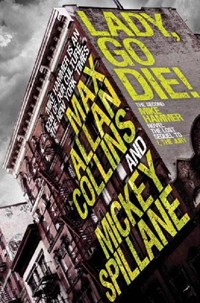
Hammer’s distrust of authority and self-reliance coupled with Spillane’s dramatic plotting, laced with its heady mix of casual sex, brutal violence, and hardboiled dialogue par excellence, struck a chord with the post-war American public. Veterans wanted a brand of fiction that recognised their sacrifice and their anger. Spillane delivered this, in spades.
In later life, Spillane befriended his biographer and fellow crime writer Max Allan Collins who, following Spillane’s death in July 2006, became his literary executor. Alongside his own work such as The Road to Perdition and the Quarry series, Collins has been completing unfinished manuscripts discovered amongst Spillane’s papers and readying them for publication. Lady, Go Die! isn’t the first of these to appear, but as the lost second Mike Hammer novel, it is the most anticipated so far. (You can read our interview with Collins here.)
The book begins shortly after the end of events in I, The Jury with Hammer and his secretary Velda, who also happens to be a licensed private eye, spending a weekend away from the big city in Sidon, Long Island. The plan is to let the heat die down after Hammer killed Charlotte Manning at the end of the Williams case, and for the couple to explore their emerging romantic relationship.
These plans have to be put on hold when Hammer spots some local police working over a man in a back alley. Hammer is not the kind of guy to step back and let this happen, particularly when he recognises one of the cops as Dekkert – a man thrown off the New York force for corruption. Hammer does what he does best – apart perhaps from bedding ‘twists’ – and after being at the wrong end of some physical violence and verbal humiliation, the Sidon police admit they were resorting to desperate measures to solve a missing persons case.
Sharron Wesley was a leading socialite and good time girl who murdered her first husband. He was a glorified pimp of a manager who beat her. The man had been found innocent of by an all male jury of the murder of her second husband, a millionaire industrialist. When Wesley’s drowned body turns up naked astride the town’s horse statue, Hammer gets involved. What follows takes in an illegal gambling operation, the New York mob, small town corruption on a large scale, and further murders. The odds against Hammer lengthen as he realises he is not just solving the murder of Sharron Wesley, but also must capture a sex killer who has Velma in his sights. Along the way Hammer is helped by NYPD detective Pat Chambers NYPD and the alcoholic local coroner, Doc Moody.
Any concerns I had about how this book was assembled dissipated as I read it. Collins, through his personal and scholarly relationship with Spillane, is the ideal man for the job. Where one author’s writing ends and the other’s begins is impossible to detect. The plot, of a heroic incorruptible stranger coming in to deliver justice and clean up the town is a familiar one but is handled deftly and the story just barrels along. Where the authors excel is in the dialogue. Hardboiled to a T, there is a memorable line on almost every page. The ending is a spectacular variation on Horace McCoy’s noir masterpiece They Shoot Horses, Don’t They?
Mickey Spillane may not enjoy the literary reputation of Raymond Chandler or break ground in the manner of Dashiell Hammett, but more than 65 years after his greatest creation first came in to print, his books remain as vibrant as ever.
Titan Books
Print/Kindle/iBook
£10
CFL Rating: 4 Stars